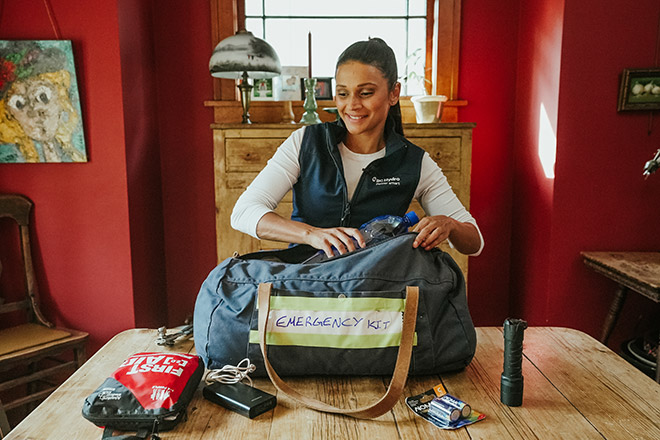Can your household survive 72 hours without power?

Half of British Columbians don't have an emergency kit, and most don't have a plan
It doesn't happen often, and it may never happen to you. But when an extended power outage or other emergency strikes, will you have a plan and supplies in place to keep you safe and comfortable?
As we head into storm season in B.C., it's time to put together, buy, or update your 72-hour emergency kit and to ensure that everyone in your home knows the plan for how to stay safe, what to eat and drink, and how to communicate with others when an emergency strikes at home or while away.
If you haven't put much thought into preparing for an outage, you're not alone. A 2020 BC Hydro report [PDF, 689 KB] found that 30% of British Columbians polled had taken no steps to prepare for an outage, and half didn't have an emergency kit on hand.
We'll get into detail about emergency kits and preparedness below, but check this list to see how prepared you are:
- Get prepared: Have an emergency preparedness kit ready that will last at least 72 hours. The kit should include a first aid kit, bottled water, non-perishable food items, a flashlight and batteries, a battery pack for your cell phone, warm clothes and blankets, among other things.
- Have a plan: Make a contingency plan with your household, and ensure that all who live with you understand it.
- Stay safe: A downed line is an emergency, and customers should stay back at least 10 metres and call 9-1-1 immediately should they encounter one.
- Know the rules: Keep refrigerator and freezer doors closed tight during an outage to avoid food spoiling. A freezer that is fully packed will hold food safely for up to 48 hours; a freezer that is half full will hold food safely for up to 24 hours.
- Stay updated: For information on preparedness, visit bchydro.com/staysafe and for up-to-date outage information, visit bchydro.com/outages.
Did you know? The rule of thumb is to store enough bottled water to provide four litres of water, per person, per day. And don't forget the pets.
Prepare your home for a power outage
Enter to win an emergency kit
This month, we want to help you get prepared for a power outage. Find us on Instagram and Facebook for your chance to win a fully stocked emergency kit. Read the contest rules [PDF, 200 KB].
What's in a household emergency plan, and why it matters
Prepared BC's variety of excellent guides includes a fill-in-the-blanks Household Emergency Plan [PDF] that should be a go-to resource for every home. Divided into two sections – communication planning and preparing at home – it acts as a resource for phone numbers, email addresses and meeting places, plus vital information about pets, health authorities, electricity and gas providers.
Imagine what happens if an adult isn't around and a kid, senior, or teen is tasked with covering the basics. Do they know where the water shutoff is? Do they have a nearby emergency contact? Do they know where your emergency kit is, and how to operate the hand-crank radio in the kit?
Prepared BC also offers guides for other specific situations, including specific guides for extreme heat, floods, earthquakes, and wildfires. There are also separate guides for apartment and condo dwellers, people with disabilities, people with pets, and for small businesses.
Building your own emergency kit
The Government of B.C. offers a detailed list of what should be in a build-your-own emergency kit and includes one priority message: "Have plenty of water". Most people need four litres per day, so if you want enough for three people for 72 hours, you'll need 36 litres.
Know the difference between a household emergency kit and a grab-and-go bag. The emergency kit is the big version that includes everything you need to survive 72 hours without power at home. Store some water in the kit, and have the full supply stored in an easy-to-access location in your home. The grab-and-go bag is for the basics you'll need if you're forced to leave your home, and the Prepared BC website recommends that each family member has a grab-and-go bag.
- Video: Building an emergency kit: Think 'camping at home'
- Video: Emergency kit vs. grab-and-go bag: What's the difference?
- Video: What to pack in your grab-and-go bag
Buying an emergency kit
72hours.ca has a variety of emergency kits designed for one to four people, most tucked into backpacks. The 3-person deluxe kit – including food and water with an up to five-year shelf life – is available for $270. It has all you need, from emergency sleeping bags and tube tents to a hand-cranked light/radio/USB charger.
Canadiansafetysupplies.com has similar options, with a two-person kit available for $171.
And some options go a step further. A two-person survival kit sold by bcquake.ca is designed specifically to keep you going for a potentially longer duration following the big earthquake that will happen sooner or later in B.C. It includes the usual 72 hours worth of food and water, but tosses in a foldable camp stove, and is priced at $297.
Related: